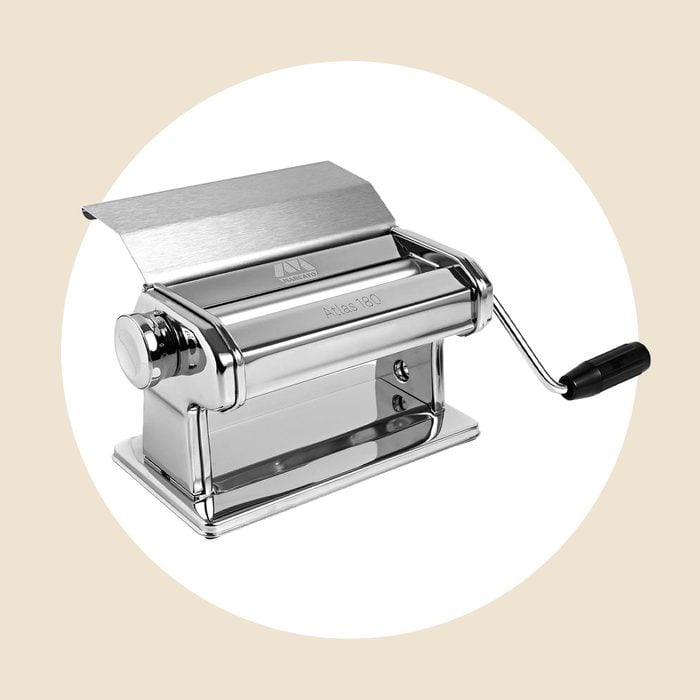
Marcato Made In Italy Atlas 180 Slide Manual Pasta Machine
As the wider version of the classic Marcato Atlas Pasta Machine, the Atlas 180 produces more pasta in less time. Uniting simplicity with versatility, it features a 9-numbered adjustable dial, so you can roll homemade pasta to your preferred thickness—.8mm to 4mm—at the touch of a button.
Using the machine was a breeze: I shaped my homemade pasta dough into a rectangle about 0.5-inches thick before feeding into the roller to form thin sheets. I then fed it through the cutters to shape the noodles. From start to finish, I had perfectly cut pasta in under five minutes!
The Marcato features two pasta cutters for making spaghetti and fettuccine. And you can purchase up to 12 additional attachments for other types of noodles, including pappardelle, linguine and capellini (talk about endless pasta-bilities!).
I especially liked that the Marcato’s roller is nearly 7-inches wide (which is wider than similar manual models on the market), which meant each crank of the handle generated more pasta in less time. I was also impressed by the sharp cutter blades, which resulted in perfectly cut noodles every time.
While this best pasta maker is a little pricier than other manual models on the market, its performance and time-saving features make it well worth the extra cost. Plus it was extremely fun and easy to use—just load the dough and crank the handle. Now you just need a pasta sauce and you’ll be on your way to an authentic Italian experience.
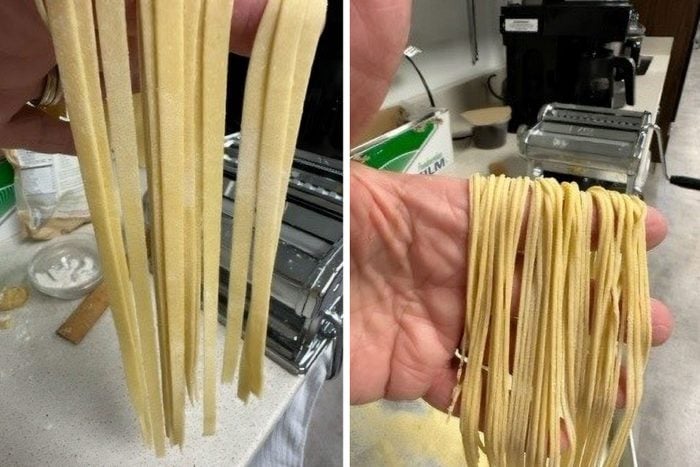
Pros
Solid construction and performance
9 adjustable thickness level settings and 2 pasta cutters
Wide roller/cutter allows for making more pasta more quickly
Sharp blades produced clean cut noodles
12 additional cutters available for purchase for more pasta variations
Cons
At the higher price range for manual models
Requires about 2-inches of counter overhang for attaching clamp (which is pretty standard for these types of pasta makers)
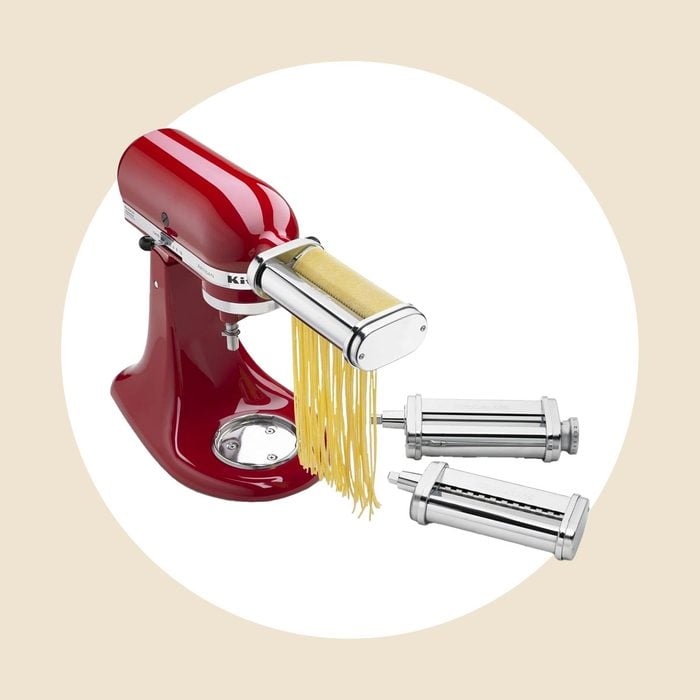
Kitchenaid Ksmpra Stand Mixer Attachment Pasta Roller & Cutter
If you already own a KitchenAid Stand Mixer, you’re in luck. The brand’s 3-Piece Pasta Roller & Cutter Attachment Set is compatible with any KitchenAid stand mixer model, so you can save space and money by simply purchasing the attachments. And if you don’t currently own a mixer, here’s how to choose which KitchenAid stand mixer is right for you.
Out of the box, the stainless-steel attachments—which include a roller and two cutters for fettuccine and spaghetti—are heavy duty and very well made. Each part attaches easily and securely to the mixer’s power hub for motorized operation. The roller has a dial on the side, so you can adjust your pasta thickness to seven varying levels, and from there you set your mixer to speed level two to convert your KitchenAid into a pasta-making machine.
While I love the simplicity of a manual pasta maker, I have to admit that after using the KitchenAid for a few minutes, I was ready to trade in my hand-crank machine for this beauty. Having my extra hand free, it was so much easier to roll, cut and catch the pasta. And as a result, I had more uniform sheets and noodles! I also liked how visible the process was with the KitchenAid; with the manual models, I was catching the noodles in the back without a good view of what was happening.
The only drawback is that the roller and cutters are separate, and have to be attached one at a time. This means rolling all the dough first and having to stack the pasta sheets (I used parchment paper in between each layer), and then attaching the cutter to cut all the pasta. While I thought this process might take awhile, I was pleasantly surprised to find it didn’t take any longer than rolling and cranking by hand.
While this 3-piece set will be enough to get you started, KitchenAid also offers an assortment of other noodle-making attachments and accessories. Here’s our review of the KitchenAid Pasta Press.
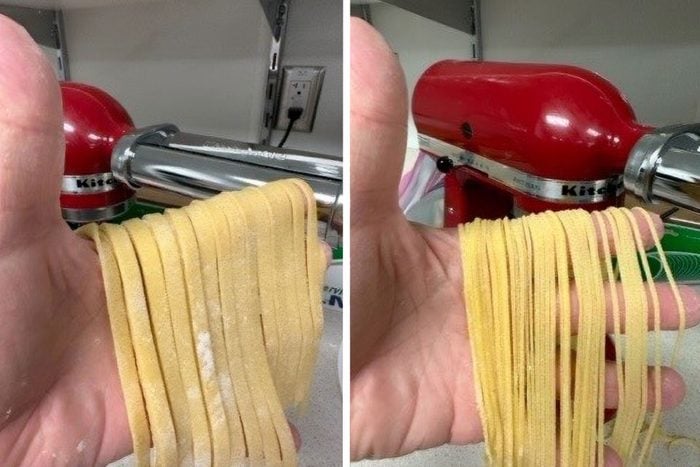
Pros
Compatible with any KitchenAid stand mixer
Uniformity of pasta sheets and noodles was superior compared to manual models (was able to use both hands to feed dough in)
7 adjustable thickness level settings and 2 pasta cutters
Easy to use, no need to clamp onto counter
Includes silicone brush for easy cleaning
Cons
Pricey (the attachments alone cost more than the manual models on our list)
Roller and cutters are separate and have to be attached/used one at a time
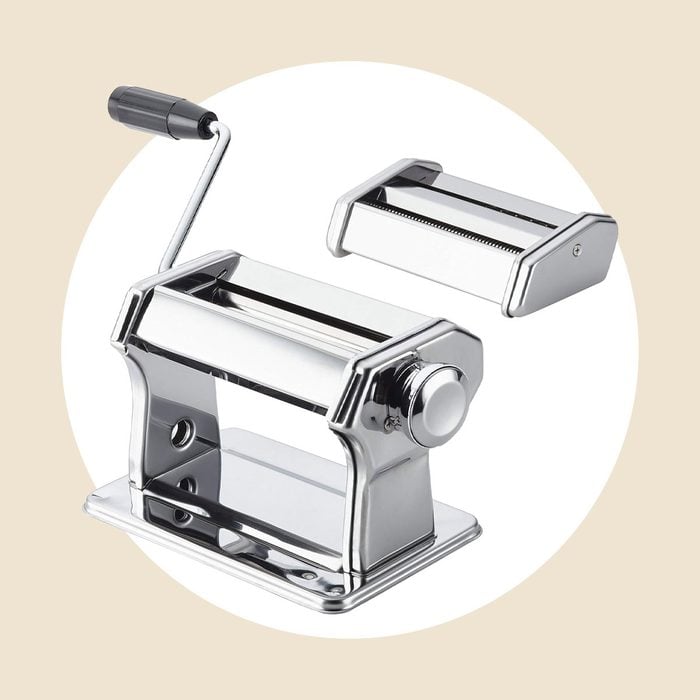
Anolon Gourmet Prep Chrome Plated Pasta Maker Ecomm Via Amazon.com
While I was pleasantly surprised by the Anolon Gourmet Pasta Maker‘s performance, I was equally impressed with the price. At under $40, this budget-friendly option allows you to put more of your hard-earned money toward pasta ingredients and wine.
Out of the box, the Anolon is noticeably lighter than the other manual machines. Similar to the other models, it features a clamp to attach the base to the counter, and a removable handle for rolling and cutting. It features a seven-position selector knob for adjusting the pasta thickness, as well as two cutter attachments for fettuccine and spaghetti.
The instructions feature real photos of both setup and operation, making it incredibly easy to use. And when it’s time to clean, the machine is easy to wipe down with a dry towel and a dry, soft brush. Overall, the Anolon was a very quality machine for the price, and would make a perfect gift for any home chef.
What to do with all that cut pasta? Hang it on this pasta drying rack, or one of these other must-have pasta making tools.
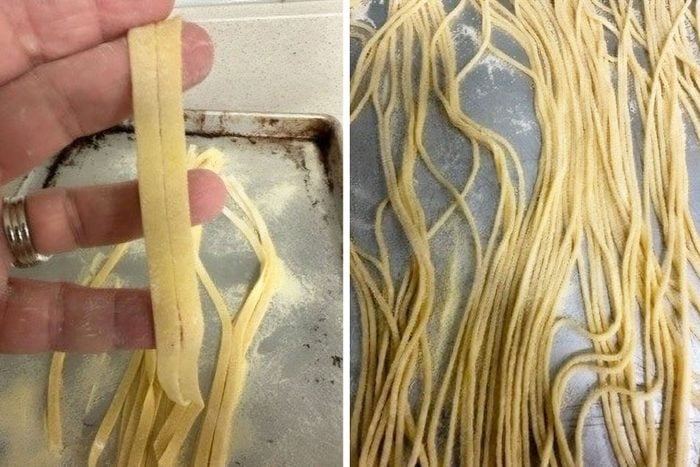
Pros
Quality pasta maker at an affordable price
7 adjustable thickness level settings and 2 pasta cutters
Easy-to-use instruction with photos
Cons
A few strands of pasta did not cut completely (but not enough to deter a buyer from purchasing)
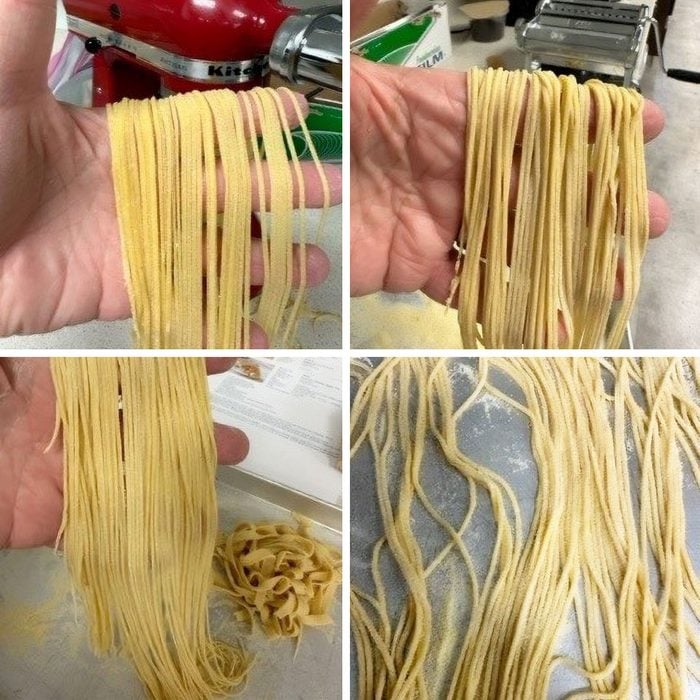
How We Tested Pasta Makers
To find the best pasta makers on the market, I researched both manual and electric models, reading dozens of user reviews and ratings and comparing each product’s strengths and weaknesses. From there I identified nine test-worthy models and spent one week making pasta. (I can think of worse ways to spend my week!)
I utilized each machine’s pasta cutter attachments, and if provided, each manufacturer’s pasta dough recipe. While doing so, I took the following key factors into consideration:
Operation: Is it intuitive and straightforward, or confusing and complicated? Does it require a lot of hands-on work and elbow grease? How long did the machine take to produce fresh pasta?
Features: What built-in features does the machine include? Does it allow for customization of pasta thickness? If so, how many variations? What types of pasta noodles can you make with the available cutters? Are additional cutter attachments available for purchase?
Overall performance: Was the final product smooth and uniformly cut? Or jagged and stuck together?
Additionally, I paid special attention to footprint, ease of cleaning and price.
After testing, only three machines earned the Test Kitchen-Preferred stamp of approval. Each top-performing machine was then sorted into categories based on performance, type (manual vs. electric) and cost.
Meet the Tester

As prep kitchen manager, I lead the prep kitchen team to ensure all food is ready for our recipe testers and associate culinary producers, as well as for our food stylists prior to being shot in our photo and video studios.
As a lifelong foodie, I bring recipes to life and contribute my expertise to articles about cooking and baking techniques and kitchen tools. I have worked in the hospitality industry for most of my career, catering and teaching cooking classes.
Ever since my youngest son took a pasta making class in Florence, Italy, my family has enjoyed gathering for pasta night. We all roll, cut and cook the pasta before sitting down together for a great meal. A quality pasta maker not only produces authentic-tasting noodles for freshly prepared dinners at home, but it also lends itself to a new family tradition. I was thrilled to lead the testing efforts in identifying the best pasta makers on the market today.
What to Look for When Buying a Pasta Maker
With so many pasta makers on the market, how do you know where to start? The following important considerations will help you find the best pasta maker for you:
Manual vs. electric: Manual pasta makers require you to be more hands-on. They secure to your countertop and feature a crank handle for manual rolling of dough into the machine. Manual pasta makers excel at making smooth, thin sheets of dough, so they’re often preferred for lasagna or ravioli. Electric machines, on the other hand, are easier to use. And because they often contain a mixer, they help prepare the dough for you (but you still have to cut it to your preferred length as it’s extruding).
Roller length: Most standard models contain a 5.5-inch roller, which provides ample space for dough. However, if you’re hoping to get more pasta out of each batch, consider upgrading to a wider roller to make more noodles in less time.
Settings: Most pasta makers contain an adjustable knob for customizing your noodle’s level of thickness. If that’s something that’s important to you, be sure to confirm whether the number of adjustment settings will suffice for your pasta-making needs.
Noodle cutters: Standard pasta machines come with roughly two cutters–typically for making spaghetti and fettuccine. If you’re hoping to make a variety of noodle dishes, check to see whether the manufacturer offers additional attachments to incorporate into your pasta-making repertoire.
Price/value: If you plan to make pasta on the regular, consider investing in a solid model with built-in customization and attachments. If you plan to make pasta less often, there are still quality options that will get the job done for a fraction of the price.
FAQs
What is the best pasta maker?
While this depends on your needs and budget, the Marcato Atlas 180 was our top pick for manual pasta maker, and the 3-Piece Pasta Roller & Cutter Attachment Set (when paired with a KitchenAid mixer stand) was our favorite electric pasta maker. But if you’re looking for a more budget-friendly option, we recommend the Anolon Gourmet.
Is it worth getting a pasta maker?
If you’re looking to incorporate homemade noodles into your dinner line-up, a quality pasta maker is worth the investment. While store-bought pasta is fairly cheap, fresh noodles are so much better. Besides, a pasta maker is a great way to kick off a new family tradition.
How long does homemade pasta last?
Compared to dry pasta purchased from the store, fresh pasta contains perishable ingredients, and must be cooked immediately or stored in the refrigerator and used within one day. If you need more time, transfer your fresh pasta to the freezer, drying it in a single layer on a baking sheet for 15 minutes before transferring the pasta to freezer-safe bags. In the freezer, it will stay good for about eight months.
Why Trust Our Test Kitchen?
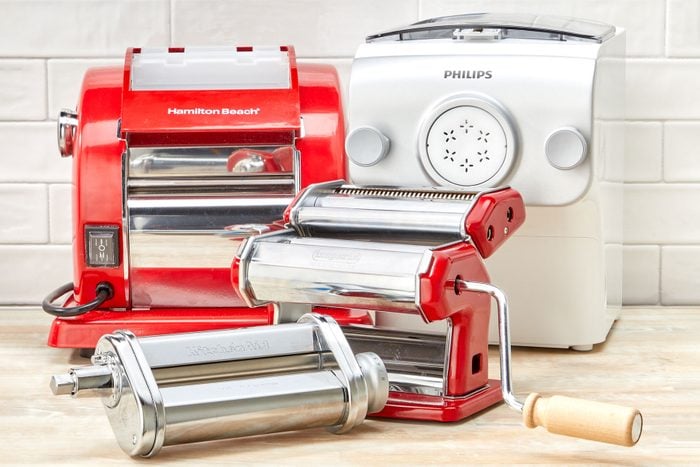
At Taste of Home, we’re serious about good food. That’s why every single recipe that our readers submit gets reviewed, made and sampled by our team of culinary experts. We want to make sure that everything from our kitchens deserves the label Test Kitchen-Approved.
The same goes for products. Our pros want to know what foods, gadgets and cleaning supplies are the best to fill your pantry and home. We put every product through a thorough testing process. Then our Test Kitchen team chooses the winners. Those best-tasting and top-performing products get our stamp of approval.
Originally Published: February 14, 2024
>>> Read full article>>>
Copyright for syndicated content belongs to the linked Source : TasteOfHome – https://www.tasteofhome.com/collection/best-pasta-makers/































